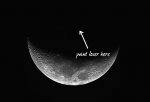Advertising using a Laser - On the Moon
So the Marketing department decided that they wanted something that would blow away the competition by projecting the company logo on the moon! The first question would be: How much power does it takes to put a spot on the moon that could be seen on its dark side (forget about competing with the Sun!)? First we do the calculation for a small spot, then for something reasonable.
Using a laser with an expander/collimator producing a 0.6 meter diameter beam (the largest one Engineering could locate at reasonable cost), the divergence would be on the order of 1.0 microRadian (for 532 nm light) so at 240 thousand miles, the spot would be about 1/4 mile in diameter. Then it comes down to how much power you need in a 1/4 mile diameter circle (about 400 meters) to be noticeably brighter than the dark side of the moon. If we assume that a 10 mW laser can illuminate a 1 meter diameter region with adequate photons (this is a totally wild guess), then extrapolating to 1/4 mile, it isn't that much - only about 1,600 WATTs. (This brightness would be very roughly similar to that of a white wall illuminated with a new clear 20 W incandescent lamp at a distance of 10 feet.) Of course, a 1/4 mile diameter region on the moon is darn small (1/8,000th of its diameter). So, for a reasonable size advertisement (unless the Finance department approves free Celestron telescopes for everyone on Earth!), a nice size would be 1/8th the moon's diameter or 250 miles. At least you could save on the beam expander/collimator since your average laser will do 1 or 2 mR! But the power goes up a bit - to 1.6 GigaWatts. That's about the right size for my next green DPSS laser - though the multi-GW rated pattern head might be a bit of a problem!

If all you have is a 100 W CW laser (which is about the limit of technology today for a visible laser, or at least approaching it), it's much tougher. While 100 W of laser light would seem to be quite a lot and definitely very bright, it is really only a similar amount of visible light to what is put out by twenty, 100 W incandescent lamps! So, even if our spot were only 1/4 mile in diameter, think of trying to illuminate an area greater than 50 football fields with 20 desk lamp-class light bulbs! Perhaps the Celestrons will need to be fitted with night vision scopes.

(From: Steve J. Quest (squest@att.net).)
I fired a collimated 63 to 67 watt visible green (532 nm) beam at the moon once, shooting for the corner cube reflectors placed there by Apollo 11 (retro-reflectors). My sewer pipe collimator produced a beam diameter of about 80 mm. I viewed the area where I expected to see the beam reflection using a 1 meter Celestron reflector telescope. I did see very faint, very tiny green scintillations, but they were NOT visible to the naked eye! Thus any dream of "moon writing" is out of the question. This was in the middle of winter, during a new moon (the air was VERY clean).
(From: Sam.)
That's cheating since there would be no way to encode an advertisement on the returning beams. But is this even credible? Did you do the obvious experiment to confirm that you were seeing a return from the moon and not from local dust?
Let's do a bit of calculation. Assuming an 80 mm outgoing beam diameter TEM00 beam, the divergence at 532 nm will be about 7.5 microRadian resulting in a spot of about 1.88 mile diameter on the moon - an area of about 98 million square feet. (Sorry about the mixed units!) Assuming 60 W makes it to the moon, a 1 foot square corner cube retro-reflector will thus intercept about 0.6 microWatt of incident power. This will be reflected with a divergence much worse than the original because at the very least, the retro-reflector prisms are smaller - say 50 mm across and each bounces back its own beamlet which will not combine in any useful way - the corner cube array is not an imaging optic nor a phased array. (This doesn't consider how the outgoing divergence contributes to the returning divergence which will make it even larger). The spot on the Earth will then be about 3 miles across or 200 million square feet or 18,000,000 square meters. So, the Celestron may have seen perhaps 0.6 uW/18,000,000 =
33 FemtoWatts (3.3x10-14 W).
And, what about the 1.88 mile diameter spot on the moon's surface lit by 60 watts of light? The diffuse reflection will spread the returning light over a huge area of space. That calculation is left as an exercise for the student.

So I may be off by two orders of magnitude one way or the other (probably the other). Could you see a few dozen FemtoWatts competing with Earth glow on the moon's dark side?
The returned power would be much less from the retro-reflector if the laser didn't produce a TEM00 diffraction limited beam. If that 60+ watts was from a LaserScope, the divergence would be 20 or 30 times worse than in the ideal case. Figure the returned power to be reduced by a factor of a few thousand.

We're talking about much less than 1 photon/second.






